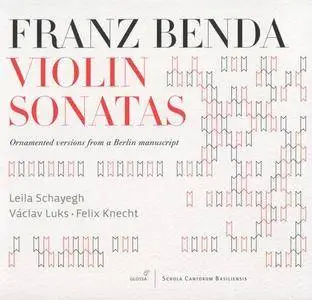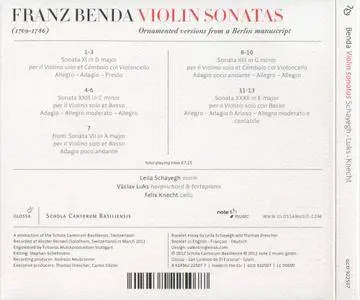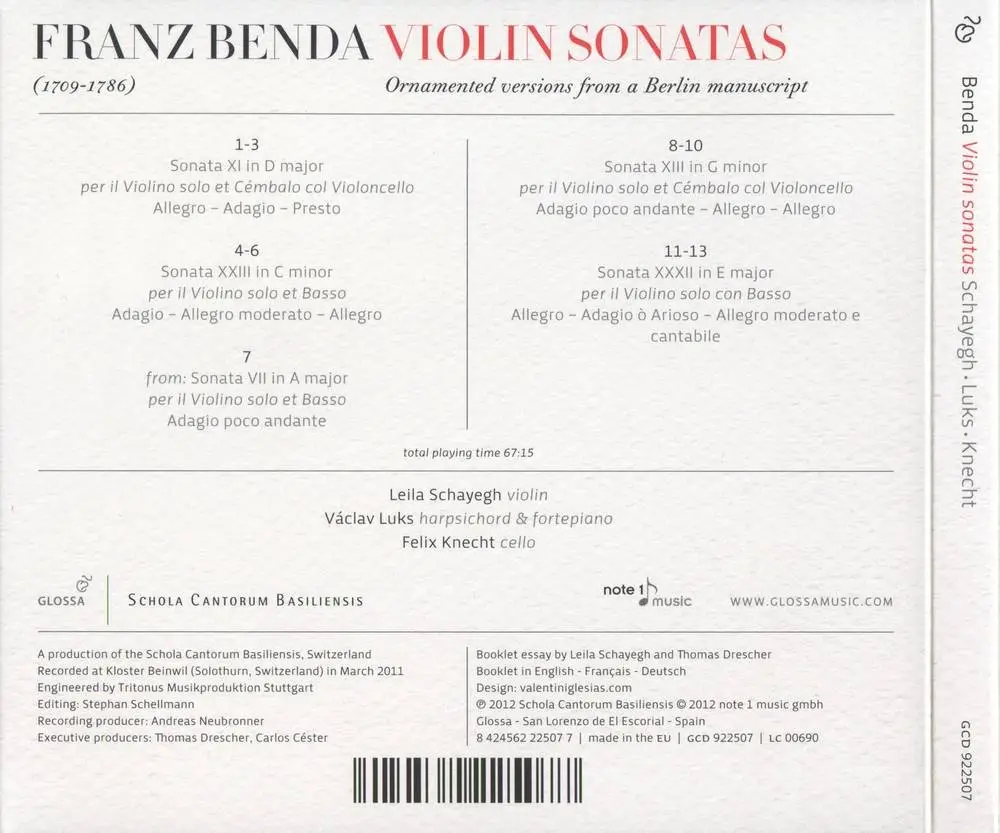Leila Schayegh, Vaclav Luks, Felix Knec - Franz Benda: Violin Sonatas (2012)
EAC | APE (image+.cue, log) | Covers Included | 67:15 | 414 MB
Genre: Classical | Label: Glossa | Catalog: GCD 922507
EAC | APE (image+.cue, log) | Covers Included | 67:15 | 414 MB
Genre: Classical | Label: Glossa | Catalog: GCD 922507
Leila Schayegh, Václav Luks, and Felix Knecht present four of Franz Benda’s violin sonatas (and a movement extracted from another sonata) from a collection of 34 ornamented examples of the genre included in manuscript form among the holdings of the Berlin State Library. The ornamentation, provided for both the slow movements, for which Benda earned a reputation, as well as for faster ones, could serve as a sort of compendium of German period practice (Schayegh’s own notes suggest that the works hail from about 1760). The first sonata in the program, No. 11 in the manuscript, sounds Haydnesque (although Charles Burney deemed that among the Berlin composers, only Benda and Carl Philipp Emanuel Bach had truly developed styles of their own) in its melodic design; the ornamentation flies thick and fast from the outset of its first-movement Allegro. The ensemble accompanies the solo violin in several different ways throughout the program, in the 11th Sonata enlisting harpsichord and cello; the harpsichord here provides a bright underlay for violinistic encrustations of ornamentation. Schayegh produces a transparent timbral lightness from her 1675 Andrea Guarneri, which matches the harpsichord’s jewel-like sonority. The slow movement (with its own brief cadenza near the end) serves as the first example of the kind of melodic writing for which Benda achieved a reputation in his own day (he had worked as a singer before he became a violinist). Like Giuseppe Tartini, he apparently valued the instrument’s melodic capabilities, though Benda’s sonatas demand great facility from the violinist in addition to a keen sense of their lyrical possibilities. The ensemble sounds brisk but songlike in the Presto finale.
In the second sonata, No. 23, the fortepiano assumes the solo responsibility for the continuo part ( basso in the title). This work follows the pattern familiar from works by Tartini (and even Giovanni Battista Somis), of a moderately paced movement followed by one a bit faster and capped off by an even quicker one. Luks’s fortepiano, a modern instrument made after a 1726 instrument made by Bartolomeo Cristofori, matches Schayegh’s sonorities, though she displays a tonal richness in the lower registers that hardly found expression in Sonata No. 11.
Harpsichord and cello return in the slow movement (Adagio poco andante, which also features a cadenza at the end) from the Seventh Sonata, its poignant sensibility bleeding through the figuration surrounding the main melody. The same instrumentation composes the continuo grouping for the 13th Sonata, also cast in three movements (the first, slow, the second two, fast and faster). Schayegh’s notes suggest that while the heaviest encrustations of ornaments appear in slow movements, the fast ones display a wide variety of procedures of varying the material, and that may account for the greater simplicity of movements like this sonata’s final Allegro.
Sonata No. 32 opens with an Allegro that struts breathtakingly in double-stops but also features bursts of ornamentation, pyrotechnical display in Schayegh’s reading. The choice of fortepiano as the continuo instrument highlights the movement’s bounce. The slow movement throws a double punch near the end, with a buildup of figuration leading to a cadenza. The finale relies on melodic appeal rather than virtuosic bravado.
Schayegh’s tone, not always mellifluous, sounds a great deal different from the tart wheezing that earlier period practitioners might have produced, and Glossa’s engineers have captured it vividly, though the clarity they’ve brought to the recorded sound represents all the instruments in sharp focus. Schayegh’s program overlaps in only one Sonata (No. 23 in C Minor) the collection made by violinist Hans-Joachim Berg and harpsichord player Naoko Akutagawa on Naxos 8.572307 (also featuring period ornamentation, Fanfare 35:4). While I recommended their performances, listeners may find a warmer graciousness in Schayegh’s readings; the engineers for both make the violins sound somewhat abrasive. In reviewing violinist Anton Steck’s readings of six of Benda’s sonatas (none of which overlap with Schayegh’s program) with Christian Rieger, on CPO 777 214, Fanfare 32:1, I noted that Steck and Rieger’s instruments “produce consistently ingratiating textures, though there can be no mistaking Steck’s violin for a modern one.” And though he may be playing from an older edition, there’s no resisting his exuberant sparkle in the second movement of the opening Sonata in C Major. In that same review, I disparaged the textures produced by Ivan Zenatý and his ensemble (Pwre Hejnýy, cello, and Jaroslav T?ma, harpsichord, on Arta 1022-2111, which I reviewed in Fanfare 18:6. Zenatý plays with a great gusto, but many will feel that whatever he can do will necessarily fall short of the effect of the original ornaments. For those interested in exploring Benda’s work, in this native environment, Schayegh’s collection should provide a heady enough brew as an introduction, and because of the lack of significant overlap, should stand alongside Berg’s collection, their differences complementing each other in creating a richer understanding of the composer’s aim of creating a sweetly melodic repast, richly glazed. Highly recommended. – Robert Maxham
Track List:
Sonata XI in D major (Lee III-25)
"per il Violino solo et Cembalo col Violoncello"
1. Allegro
2. Adagio
3. Presto
ВС: harpsichord & violoncello
Sonata XXIII in C minor (Lee III-9)
"per il Violino solo et Basso"
4. Adagio
5. Allegro moderato
6. Allegro
вс: fortepiano
from: Sonata VII in A major (Lee III-103)
"per il Violino solo et Basso"
7. Adagio poco andante
ВС: harpsichord & violoncello
Sonata XIII in G minor (Lee III-89)
"per il Violino solo et Cembalo col Violoncello"
8. Adagio poco andante
9. Allegro
10. Allegro
ВС: harpsichord & violoncello
Sonata XXXII in E major (Lee III-50)
"per il Violino solo con Basso"
11. Allegro
12. Adagio ò Arioso
13. Allegro moderato e cantabile
вс: fortepiano & violoncello
Performers:
Leila Schayegh
violin (Andrea Guarneri, Cremona, 1675)
Vaclav Luks
harpsichord (Martin Skowroneck, 1987, after Michael Mietke)
fortepiano (Denzil Wraight, 2005, after Bartolomeo Cristofori, 1726)
Felix Knecht
violoncello (workshop of Carlo Antonio Testore, Milano, 1727)
EAC extraction logfile from 29. October 2013, 20:16 for CD
Unknown Artist / Unknown Title
Used drive : SONY CD-RW CRX320EE Adapter: 3 ID: 1
Read mode : Secure with NO C2, accurate stream, disable cache
Read offset correction : 6
Overread into Lead-In and Lead-Out : No
Used output format : Internal WAV Routines
44.100 Hz; 16 Bit; Stereo
Other options :
Fill up missing offset samples with silence : Yes
Delete leading and trailing silent blocks : No
Installed external ASPI interface
Range status and errors
Selected range
Filename C:\Scanned\2\CDImage.wav
Peak level 93.4 %
Range quality 100.0 %
CRC B3896890
Copy OK
No errors occured
End of status report
Unknown Artist / Unknown Title
Used drive : SONY CD-RW CRX320EE Adapter: 3 ID: 1
Read mode : Secure with NO C2, accurate stream, disable cache
Read offset correction : 6
Overread into Lead-In and Lead-Out : No
Used output format : Internal WAV Routines
44.100 Hz; 16 Bit; Stereo
Other options :
Fill up missing offset samples with silence : Yes
Delete leading and trailing silent blocks : No
Installed external ASPI interface
Range status and errors
Selected range
Filename C:\Scanned\2\CDImage.wav
Peak level 93.4 %
Range quality 100.0 %
CRC B3896890
Copy OK
No errors occured
End of status report
[CUETools log; Date: 31.05.2018 14:29:53; Version: 2.1.5]
[CTDB TOCID: z_DHLJX277KTAEk0YQUBUa9AInc-] found.
Track | CTDB Status
1 | (6/6) Accurately ripped
2 | (6/6) Accurately ripped
3 | (6/6) Accurately ripped
4 | (6/6) Accurately ripped
5 | (6/6) Accurately ripped
6 | (5/6) Accurately ripped
7 | (5/6) Accurately ripped
8 | (5/6) Accurately ripped
9 | (5/6) Accurately ripped
10 | (5/6) Accurately ripped
11 | (5/6) Accurately ripped
12 | (5/6) Accurately ripped
13 | (5/6) Accurately ripped
[AccurateRip ID: 001fe31c-013c2e7e-980fc10d] found.
Track [ CRC | V2 ] Status
01 [30dc122c|14fa9b8e] (0+6/6) Accurately ripped
02 [e1e4dd8a|f3a855e1] (0+7/7) Accurately ripped
03 [71c4d885|d74ee30b] (0+6/6) Accurately ripped
04 [7170eebc|472d6ed8] (0+6/6) Accurately ripped
05 [d75f656b|5b0bc812] (0+7/7) Accurately ripped
06 [d3e6e5b9|8f9cc4c5] (0+7/7) Accurately ripped
07 [d3d58ad9|8074a292] (0+7/7) Accurately ripped
08 [d8fbbce6|891f1429] (0+7/7) Accurately ripped
09 [ce84e209|36f5cb18] (0+7/7) Accurately ripped
10 [5a1a9780|5cff8dd7] (0+7/7) Accurately ripped
11 [60574fc0|31856ea7] (0+7/7) Accurately ripped
12 [dd6b257c|3cf5cf99] (0+7/7) Accurately ripped
13 [64b1d26a|e48e36c1] (0+7/7) Accurately ripped
Track Peak [ CRC32 ] [W/O NULL] [ LOG ]
– 93,4 [F80010EB] [B3896890] W/O NULL
01 86,5 [2F22A869] [77BDCCAB]
02 57,9 [EDC46BBD] [1CD8E6B1]
03 75,4 [DE0FD8AD] [34AF760C]
04 77,1 [A668BA2B] [51285017]
05 82,9 [C9F54E27] [84B37B62]
06 91,9 [700FF481] [7EA9A4B0]
07 60,5 [0AE7D70F] [610B6B8D]
08 74,5 [40295C4B] [6250B025]
09 83,3 [EFBB9880] [F49F8F02]
10 92,2 [D7FB7B5B] [F37451D8]
11 86,2 [B7B818EC] [1DF9C303]
12 76,9 [BAD7FB64] [5FBF1025]
13 93,4 [A2473477] [D314FAB6]
[CTDB TOCID: z_DHLJX277KTAEk0YQUBUa9AInc-] found.
Track | CTDB Status
1 | (6/6) Accurately ripped
2 | (6/6) Accurately ripped
3 | (6/6) Accurately ripped
4 | (6/6) Accurately ripped
5 | (6/6) Accurately ripped
6 | (5/6) Accurately ripped
7 | (5/6) Accurately ripped
8 | (5/6) Accurately ripped
9 | (5/6) Accurately ripped
10 | (5/6) Accurately ripped
11 | (5/6) Accurately ripped
12 | (5/6) Accurately ripped
13 | (5/6) Accurately ripped
[AccurateRip ID: 001fe31c-013c2e7e-980fc10d] found.
Track [ CRC | V2 ] Status
01 [30dc122c|14fa9b8e] (0+6/6) Accurately ripped
02 [e1e4dd8a|f3a855e1] (0+7/7) Accurately ripped
03 [71c4d885|d74ee30b] (0+6/6) Accurately ripped
04 [7170eebc|472d6ed8] (0+6/6) Accurately ripped
05 [d75f656b|5b0bc812] (0+7/7) Accurately ripped
06 [d3e6e5b9|8f9cc4c5] (0+7/7) Accurately ripped
07 [d3d58ad9|8074a292] (0+7/7) Accurately ripped
08 [d8fbbce6|891f1429] (0+7/7) Accurately ripped
09 [ce84e209|36f5cb18] (0+7/7) Accurately ripped
10 [5a1a9780|5cff8dd7] (0+7/7) Accurately ripped
11 [60574fc0|31856ea7] (0+7/7) Accurately ripped
12 [dd6b257c|3cf5cf99] (0+7/7) Accurately ripped
13 [64b1d26a|e48e36c1] (0+7/7) Accurately ripped
Track Peak [ CRC32 ] [W/O NULL] [ LOG ]
– 93,4 [F80010EB] [B3896890] W/O NULL
01 86,5 [2F22A869] [77BDCCAB]
02 57,9 [EDC46BBD] [1CD8E6B1]
03 75,4 [DE0FD8AD] [34AF760C]
04 77,1 [A668BA2B] [51285017]
05 82,9 [C9F54E27] [84B37B62]
06 91,9 [700FF481] [7EA9A4B0]
07 60,5 [0AE7D70F] [610B6B8D]
08 74,5 [40295C4B] [6250B025]
09 83,3 [EFBB9880] [F49F8F02]
10 92,2 [D7FB7B5B] [F37451D8]
11 86,2 [B7B818EC] [1DF9C303]
12 76,9 [BAD7FB64] [5FBF1025]
13 93,4 [A2473477] [D314FAB6]
Thanks to the Original ripper unrotten!
Download:
Download:





